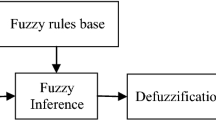Abstract
A Traction Control System (TCS) is used to control the driving force of an engine to prevent excessive slip when a vehicle starts suddenly or accelerates. The torque control strategy determines the driving performance of the vehicle under various drive-slip conditions. This paper presents a new torque control method for various drive-slip conditions involving abrupt changes in the road friction. This method is based on a PID plus fuzzy logic controller for driving torque regulation, which consists of a PID controller and a fuzzy logic controller. The PID controller is the fundamental component that calculates the elementary torque for traction control. In addition, the fuzzy logic controller is the compensating component that compensates for the abrupt change in the road friction. The simulation results and the experimental vehicle tests have validated that the proposed controller is effective and robust. Compared with conventional PID controllers, the driving performance under the proposed controller is greatly improved.
Similar content being viewed by others
References
Borrelli, F., Bemporad, A., Fodor, M. and Hrovat, D. (2006). An MPC/hybrid system approach to traction control. IEEE Trans. Control Systems Technology 14,3, 541–552.
Chun, K. and Sunwoo, M. (2004). Wheel slip control with moving sliding surface for traction control system. Int. J. Automotive Technology 5,2, 123–133.
Eker, I. and Torun, Y. (2006). Fuzzy logic control to be conventional method. Energy Conversion Manage 47,4, 377–394.
Gao, Y., Huang, R. and Zhang, Q. (2008). A comparison of three steering controllers for off-road vehicles. Proc. IMechE Part D: J. Automobile Engineering, 222, 2321–2336.
Guo, L. Z., Zhu, Q. M. and Warwick, K. (2007). Design of a minimum variance multiple input-multiple output neuro self-tuning proportional-integral-derivative controller for non-linear dynamic systems. Proc. IMech Part I: J. Systems and Control Engineering, 221, 75–88.
Ise, K., Fujita, K., Inoue, Y. and Masutomi, S. (1990). The “Lexus” traction control (TRAC) system. SAE Paper No. 900212, 153–160.
Jung, H., Kwak, B. and Park, Y. (2000). Slip controller design for traction control system. Int. J. Automotive Technology 1,1, 48–55.
Khatun, P., Bingham, C. M., Schofield, N. and Mellor, P. H. (2003). Application of fuzzy control algorithm for electric vehicle antilock braking/traction control systems. IEEE Trans. Vehicular Technology 52,5, 1356–1364.
Kukolj, D. D., Kuzmanovic, S. B. and Levi, E. (2001). Design of a PID-like compound fuzzy logic controller. Engineering Applications of Artificial Intelligence, 14, 785–803.
Lee, H. and Tomizuka, M. (2003). Adaptive vehicle traction force control for intelligent vehicle highway systems (IVHSs). IEEE Trans. Industrial Electronics 50,1, 37–47.
Li, H. and Gatland, H. B. (1996). Conventional fuzzy control and its enhancement. IEEE Trans. Syst., Man, Cybern., 26, 791–796.
Li, L., Song, J., Li, H., Shan, D., Kong, L. and Yang, C. (2009). Comprehensive prediction method of road friction for vehicle dynamics control. Proc. IMechE Part D: J. Automobile Engineering, 223, 987–1002.
Li, S., Liao, C., Chen, S. and Wang, L. (2009). Traction control of hybrid electric vehicle. VPPC’ 09, 1535–1540.
Pacejka, H. B. (2002). Tire and Vehicle Dynamics. Butterworth Heinemann. Oxford.
Sharkawy, A. B. (2010). Genetic fuzzy self-tuning PID controllers for antilock braking systems. Engineering Applications of Artificial Intelligence, 23, 1041–1052.
Shim, T. and Margolis, D. (2001). Using Ì feedforward for vehicle stability enhancement. Vehicles System Dynamics 35,2, 103–119.
Van Zanten, A. T., Ertarad, R., Pfaff, G., Kost, F., Hartmann, U. and Ehret, T. (1996). Control aspects of the Bosch-VDC. AVEC’96, 573–608.
Woo, Z. W., Chung, H. Y. and Lin, J. J. (2000). A PID type fuzzy controller with self-tuning scaling factors. Fuzzy Sets and Systems, 115, 321–326.
Yu, F., Feng, J. Z. and Li, J. (2002). A fuzzy logic controller design for vehicle abs with a on-line optimized target wheel slip ratio. Int. J. Automotive Technology 3,4, 165–170.
Author information
Authors and Affiliations
Corresponding author
Rights and permissions
About this article
Cite this article
Li, H.Z., Li, L., He, L. et al. PID plus fuzzy logic method for torque control in traction control system. Int.J Automot. Technol. 13, 441–450 (2012). https://doi.org/10.1007/s12239-012-0041-4
Received:
Revised:
Accepted:
Published:
Issue Date:
DOI: https://doi.org/10.1007/s12239-012-0041-4




